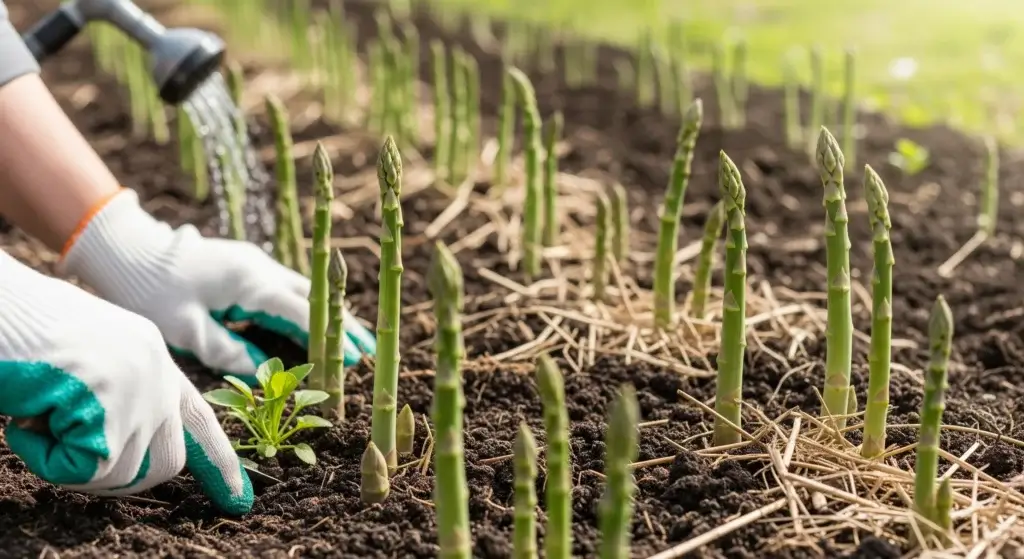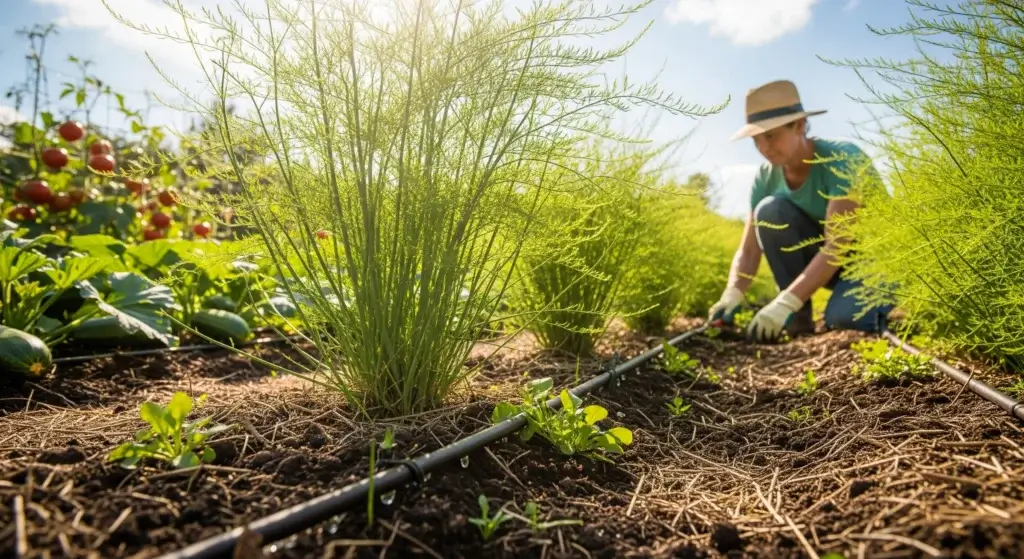
Tomato plants are a favorite for many gardeners, providing delicious fruit and a rewarding gardening experience.
However, there’s nothing more disheartening than seeing your vibrant tomato plant start to wilt.
Don’t worry; with a little knowledge and care, you can bring your plant back to life.
In this guide, we’ll explore why tomato plants wilt and how to revive them to help you maintain a thriving garden.
Why is a Tomato Plant Wilting
There are a couple of reasons why a tomato plant might be wilting.
Understanding why your tomato plant is wilting is crucial to reviving it effectively. Here are the common causes of wilting:
- Read also: Save Your Tomatoes: Tips on Blossom End Rot in Tomatoes
- Read also: Issues and Solutions: Troubleshooting Tomato Leaf Problems
Watering issues
Both overwatering and underwatering can lead to wilting.
Overwatering
- Root rot: Overwatering can cause the roots to stay submerged in water, leading to root rot. Roots need oxygen to function properly, and too much water deprives them of this essential gas.
- Soggy soil: Consistently wet soil can suffocate roots, preventing them from absorbing nutrients and water effectively.
Underwatering
- Dry soil: When the soil is too dry, the plant cannot absorb enough water to sustain itself. This leads to dehydration and wilting.
- Water stress: Lack of water causes the plant to conserve moisture, resulting in droopy, wilted leaves.
Nutrient deficiency
A lack of essential nutrients, particularly nitrogen, phosphorus, and potassium, can cause wilting.
- Nitrogen (N): Essential for leafy growth. A deficiency causes yellowing leaves and weak stems.
- Phosphorus (P): Important for root development and flower production. A lack of phosphorus results in stunted growth and dark, discolored leaves.
- Potassium (K): Vital for overall plant health and disease resistance. Deficiency leads to brown, scorched leaf edges and weak plants.
Pests and diseases
Common pests like aphids, whiteflies, and diseases such as fusarium wilt or verticillium wilt can damage the plant and lead to wilting.
- Aphids: Small, sap-sucking insects that cause yellowing and curling of leaves.
- Whiteflies: Tiny, white insects that suck plant juices, leading to weakened plants and leaf drop.
- Fusarium wilt: A soil-borne fungal disease that clogs the plant’s water-conducting tissues, causing wilting and yellowing.
- Verticillium wilt: Similar to fusarium wilt, this fungal disease blocks water flow in the plant, leading to wilting and chlorosis (yellowing of leaves).
Environmental stress
Extreme temperatures, either too hot or too cold, can cause stress on the plant, leading to wilting.
- Heat stress: High temperatures cause rapid evaporation and transpiration, leading to water loss and wilting.
- Cold stress: Low temperatures can damage plant cells and disrupt water uptake, resulting in wilting.
Root damage
Transplanting or root disturbance can shock the plant, causing it to wilt.
- Disturbed Roots: When transplanting, the roots can get damaged or disturbed, causing the plant to go into shock and wilt.
- Improper handling: Rough handling during transplanting can break or bruise the roots, impairing their ability to absorb water and nutrients.

How to Revive Wilting Tomato Plants
The good news is that wilting tomato plants can often be revived, depending on the severity and cause.
Here’s what to do:
Assess watering practices
The first thing to do is check the soil moisture.
Stick your finger about an inch into the soil. If it feels dry, your plant needs water.
If it’s soggy, you might be overwatering.
Overwatering
- Drainage: Ensure the pot has adequate drainage holes to allow excess water to escape.
- Reduce watering: Let the soil dry out completely between waterings.
- Aeration: Aerate the soil by gently poking holes a few inches deep around the base of the plant. This will improve drainage and oxygen flow to the roots.
Underwatering
- Deep watering: Give your tomato plant a thorough soaking. Aim for 1-2 inches of water to reach the roots. Use a watering can or soaker hose to deliver the water directly to the soil around the base of the plant, avoiding the leaves.
- Mulch: Apply a layer of mulch around the base of the plant to retain moisture and keep the soil cool. This will help reduce evaporation and the need for frequent watering.
- Watering schedule: During hot weather, you may need to water your tomato plants daily, especially if they are in containers. Stick your finger in the soil a couple of inches deep – if it feels dry, it’s time to water.
Improve Soil Quality
- Soil testing: Use a soil test kit to determine nutrient levels.
- Fertilization: Apply a balanced fertilizer that provides nitrogen, phosphorus, and potassium. Organic options like compost or fish emulsion can also be beneficial.
Address pests and diseases
- Inspect the plant: Look for signs of pests such as holes in leaves, sticky residue, or visible insects.
- Pest control: Use organic methods like neem oil or insecticidal soap. Introduce beneficial insects like ladybugs that prey on harmful pests.
- Disease management: Remove and destroy affected plants to prevent the spread of disease. Plant disease-resistant tomato varieties and practice crop rotation.
Provide optimal growing conditions
- Shade and shelter: Provide shade during hot weather using garden cloth or shade nets. In cold weather, use row covers or bring potted plants indoors.
- Mulching: Apply mulch around the base of the plant to regulate soil temperature and retain moisture.
Handle root with Care
- Gentle transplanting: Handle plants with care during transplanting. Water the plant thoroughly before and after transplanting to help the roots settle.
- Root care: Avoid disturbing the roots once the plant is in place. Mulch around the plant to protect the root zone.

How Long Does It Take for a Wilted Tomato Plant to Heal
The recovery time for a wilted tomato plant depends on the severity of the issue and how quickly you address it.
Generally, you can expect to see improvement within a few days to a week after taking corrective measures.
Here’s a general breakdown:
Underwatering
If underwatering is the culprit, recovery can be relatively quick.
With a good deep soak and proper watering practices going forward, you might see improvement within a day or two.
Significant wilting could take a week or so to fully bounce back.
Overwatering
Recovery from overwatering can take longer than underwatering, especially if root damage has occurred.
It could take several days to a week for the soil to dry out completely, and the plant may take additional time to recover.
Other causes
The recovery timeline for other causes like sunburn or minor root damage is similar to underwatering, taking a few days to a week.
Unfortunately, fungal diseases are usually fatal for the plant.

Can Tomato Plants Revive Themselves
Tomato plants cannot exactly “repair” themselves from wilting, but they can recover if the underlying stress causing the wilting is addressed quickly.
Here’s a detailed look at the recovery process for a wilting tomato plant:
Wilting as a signal
Wilting is a plant’s way of conserving water by reducing the surface area of its leaves, which helps prevent further water loss.
Recovery process
When the stress is addressed (like underwatering being corrected with a good soak), the plant can take up water again and restore pressure to its cells, causing the leaves to plump back up.
So, it’s not true repair, but rather a return to normal function after the stress is alleviated. However, there are limitations:
- Severity of wilting: If the wilting is very severe or prolonged, the plant cells may be damaged beyond repair, and the plant might not recover.
- Underlying cause: The ability to recover depends on the cause of wilting. Underwatering and sunburn can often be reversed, while diseases causing wilting may be fatal.

- Read also: Causes and Solutions: Troubleshooting Tomato Stem Problems
- Read also: Unlock the Secret: Tomato Plant Watering Schedule
Conclusion
Wilting tomato plants don’t have to be a permanent problem.
By understanding the causes and taking proactive steps, you can revive your plants and enjoy a bountiful harvest.
Remember to monitor your plants regularly, provide them with the care they need, and don’t be afraid to seek help if you encounter persistent problems.
FAQs
Yes, even severely wilted plants can often be revived with proper care, although the recovery might take longer.
Yes, removing wilted or diseased leaves can help prevent the spread of disease and allow the plant to focus its energy on healthy growth.



